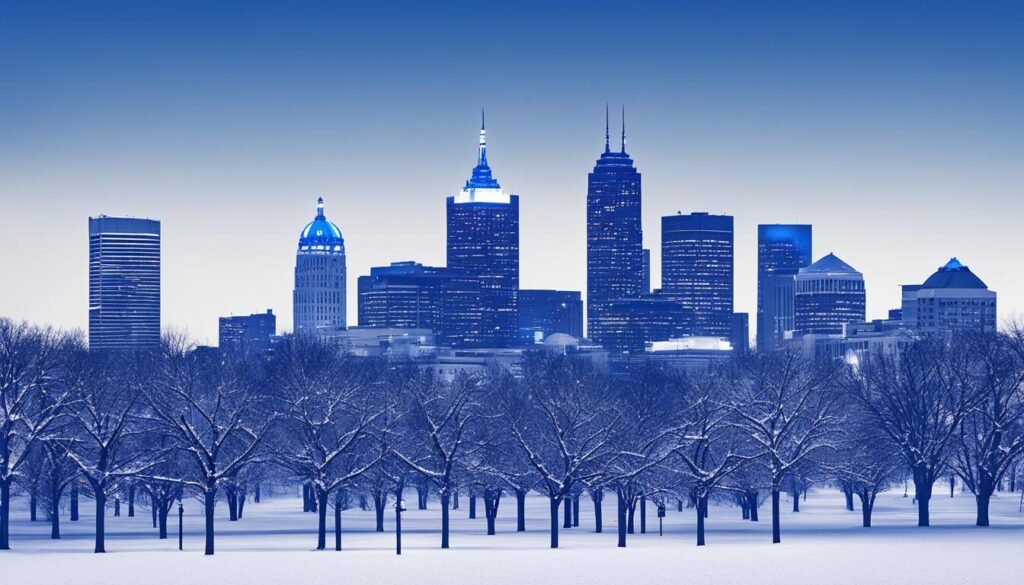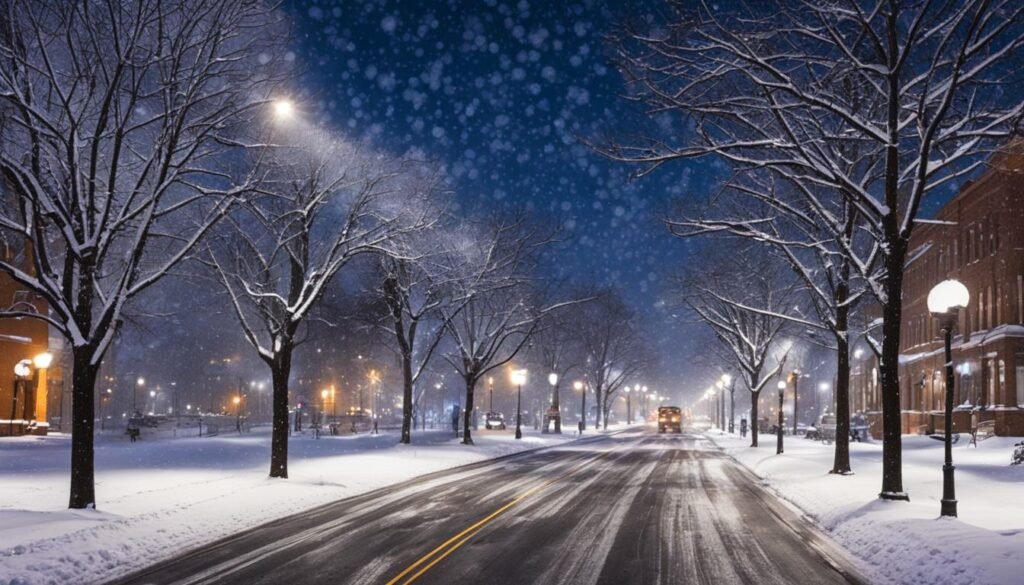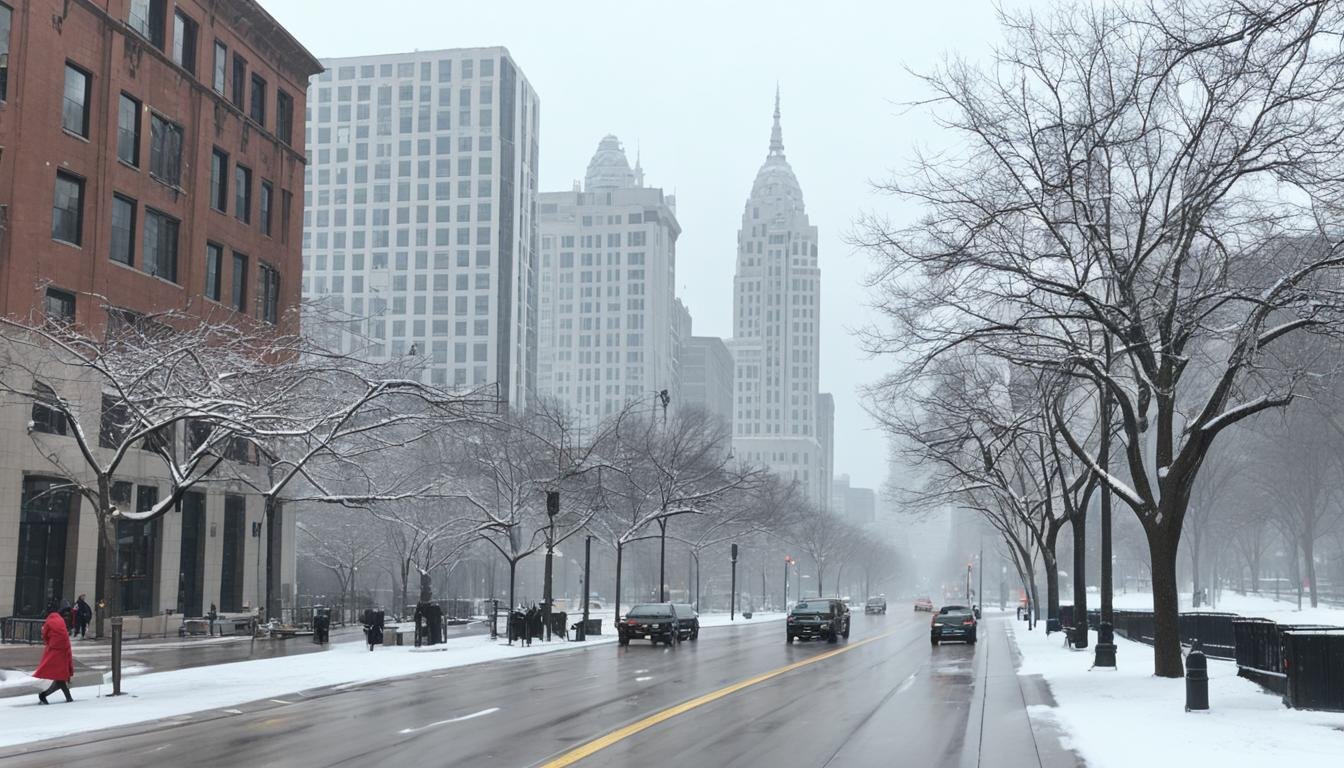As someone who has experienced all four seasons in Indianapolis, I often get asked the question: Does it snow in Indianapolis? The answer is yes, but perhaps not as much as you might expect. While winter weather is a part of life in this city, Indianapolis receives relatively low amounts of snow compared to other winter cities.
On average, Indianapolis sees around 20 inches of snowfall per year. This means that while you can expect some snow during the winter season, it may not be a winter wonderland like some other parts of the country. However, don’t let the limited snowfall fool you – winter in Indianapolis can still bring icy conditions due to freezing temperatures, making travel more hazardous.
It’s also worth noting that Indianapolis winters aren’t just about snow. Rain, sleet, and hail are common from November to March, making the season wet and unpredictable. So, while snow may not be the dominant feature of Indianapolis winters, you’ll still need to be prepared for a mix of wintry conditions.
If you’re planning a visit or are a new resident, it’s important to know what to expect in an Indianapolis winter. The climate here is defined by cold temperatures and a flat, prairie landscape that can contribute to even colder wind chills. While the average snowfall is relatively low, it’s still good to be prepared for a few snowy days each month during the winter season.
So, let’s delve into the details of what you can expect when it comes to snowfall in Indianapolis!
Key Takeaways:
- Indianapolis receives around 20 inches of snowfall per year.
- Winter in Indianapolis can bring icy conditions due to freezing temperatures.
- The city experiences rain, sleet, and hail in addition to snow during the winter season.
- Indianapolis winters are characterized by cold temperatures and a flat, prairie landscape.
- Residents can expect a few snowy days each month during the winter season.
What to Expect in an Indianapolis Winter
Indianapolis winters offer a unique blend of cold temperatures, wet conditions, and occasional snowfall. The city’s flat, prairie landscape contributes to the colder climate, and the added wind chill factor can make it feel even colder than the actual temperature. While snowfall in Indianapolis may not be as abundant as in some other winter cities, residents can still expect to experience snowy days throughout the winter season.
On average, Indianapolis receives about 2-3 inches of snow per month during the winter months. While this may not seem like much compared to other snow-covered cities, it’s still enough to create a picturesque winter scenery and provide opportunities for outdoor activities like sledding or snowball fights.
However, it’s important to note that Indianapolis winters can bring more than just snow. The city experiences wet conditions, with sleet, rain, and hail common during the winter months from November to March. These precipitation types can create slippery surfaces and potentially hazardous driving conditions.
To navigate an Indianapolis winter safely, be prepared for icy conditions by investing in quality winter outerwear, including coats, hats, gloves, and boots with good traction. It’s also a wise idea to keep an ice scraper and a small shovel in your car for clearing off snow and ice from your vehicle.
Winter Weather Tips for Indianapolis Residents:
- Dress in layers to stay warm and protect yourself against the cold temperatures.
- Wear appropriate footwear with good traction to prevent slipping on icy surfaces.
- Keep your home adequately heated and insulated to stay cozy during the colder months.
- Check weather forecasts regularly to stay informed about potential snowstorms or icy conditions.
- Plan your travel routes accordingly, allowing extra time for potential delays and icy roads.
- Keep an emergency kit in your car stocked with essentials like a flashlight, extra batteries, blankets, and non-perishable food items.
- Be cautious when driving on bridges and overpasses, as they tend to freeze faster than other road surfaces.
- Exercise caution when walking or driving near icy areas, such as parking lots or sidewalks.
While Indianapolis may not have the same winter climate as some northern cities, it still provides its own unique winter experience. Embrace the snowy days, stay prepared for the elements, and make the most of the winter season in this vibrant Midwestern city.
Snowfall Averages and Patterns in Indianapolis

When it comes to snowfall, Indianapolis experiences varying amounts each winter, creating a unique winter climate for the city. From 2012 to 2022, the recorded snowfall totals in Indianapolis ranged from as low as 8.7 inches to as high as 52.2 inches. The highest recorded snowfall in the city’s history was 52.2 inches, while the lowest was 8.7 inches. On average, Indianapolis receives about 26.5 inches of snow per year.
The snowfall in Indianapolis follows a typical pattern, with the first measurable snow usually occurring in November and the last snowfall typically happening in March. However, snowfall in October and April is rare. During the winter season, which spans from November to March, Indianapolis typically has at least an inch of snow on the ground for approximately 25% of the time.
Let’s take a closer look at the snowfall averages over the past decade:
| Year | Snowfall (in inches) |
|---|---|
| 2012 | 14.8 |
| 2013 | 8.7 |
| 2014 | 30.4 |
| 2015 | 26.2 |
| 2016 | 13.1 |
| 2017 | 20.7 |
| 2018 | 52.2 |
| 2019 | 27.5 |
| 2020 | 24.6 |
| 2021 | 34.3 |
| 2022 | 18.2 |
Key Insights:
- Indianapolis receives an average of about 26.5 inches of snow per year.
- The highest recorded snowfall in Indianapolis history was 52.2 inches.
- The lowest recorded snowfall in Indianapolis history was 8.7 inches.
- The first measurable snow usually occurs in November, and the last snowfall typically happens in March.
- Snowfall in October and April is rare.
While Indianapolis may not be known for heavy snowfall like some other winter cities, residents can still anticipate a significant amount of snow each year. The snowfall averages and patterns provide valuable insights into what to expect during the winter season in Indianapolis.
Snowfall and Snowstorms in Indianapolis

Indianapolis experiences several snowstorms each winter, with an average of 8 days per year where at least an inch of snowfall accumulates. Major snowstorms that produce more than 5 inches of snow in a day occur about once a year, while blizzards with 10 inches or more of snow are not common for the city. These snowstorms can impact travel and lead to hazardous conditions on the roads. It’s important for residents to stay updated on snowfall forecasts and be prepared for winter weather.
In Indianapolis, snowfall can range from light flurries to heavy snowstorms, and the city has experienced its fair share of challenging winter weather. Snowstorms can cause significant disruptions to daily life, including school closures, flight cancellations, and hazardous driving conditions. The city’s Department of Public Works is responsible for clearing and salting roads to ensure safe travel during and after snowstorms.
| Snowfall Levels | Frequency per Year |
|---|---|
| Less than 1 inch | 8 days |
| 1-5 inches | 4 days |
| 5-10 inches | 2 days |
| More than 10 inches | 1 day |
While snowstorms in Indianapolis may not be as frequent or severe as those in other regions, it’s still essential for residents to be prepared. Here are a few tips to navigate snowstorms:
- Stay informed: Monitor local weather reports and alerts to stay updated on snowfall forecasts. Sign up for emergency notifications from the city or county.
- Make a plan: Develop a winter weather emergency plan for your household, including communication strategies, emergency contacts, and alternative heating sources.
- Stock up on supplies: Keep a stockpile of food, water, medication, and other essentials to last at least three days in case of power outages or transportation disruptions.
- Prepare your home and vehicle: Insulate pipes, seal windows and doors, and keep the fuel tank of your vehicle at least half full.
- Stay off the roads if possible: Avoid unnecessary travel during snowstorms to allow road crews to clear the streets and minimize accidents.
By following these guidelines and being prepared, residents can navigate snowstorms in Indianapolis safely and effectively.
Conclusion
While Indianapolis may not receive as much snow as other winter cities, residents can still expect some snowfall during the winter season. The city’s winter climate is characterized by cold temperatures, wet conditions, and the occasional snowstorm. It’s important to be prepared for icy roads and invest in appropriate winter clothing. Despite the limited snowfall, Indianapolis offers plenty of ways to enjoy the winter season and celebrate the holidays. So, while it may not be a winter wonderland, Indianapolis still experiences its fair share of snow and winter weather.
FAQ
Does it snow in Indianapolis?
Yes, Indianapolis does experience snowfall during the winter season.
What can I expect in an Indianapolis winter?
Indianapolis winters are characterized by cold temperatures, wet conditions, and occasional snowstorms.
How much snow does Indianapolis receive on average?
Indianapolis receives an average of around 20 inches of snow per year.
Are there any patterns in snowfall in Indianapolis?
The snowfall totals in Indianapolis can vary each winter, ranging from as low as 8.7 inches to as high as 52.2 inches over the past decade.
How often does Indianapolis experience snowstorms?
Indianapolis experiences about 8 days per year with at least an inch of snowfall, and major snowstorms that produce more than 5 inches of snow occur about once a year.

Leave a Reply